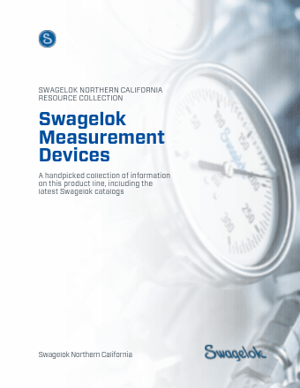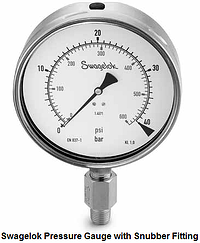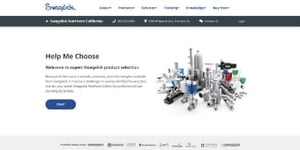Share this
FAQ: Should I fill a Swagelok pressure gauge with liquid?
by Jeff Hopkins on 12/12/13 8:00 AM
Some Swagelok pressure gauges can be liquid filled. Learn the benefits of a liquid-filled pressure gauge and an alternative to liquid filling.
 Sometimes it's a good idea to use a liquid-filled pressure gauge. Sometimes it's better to use a dry gauge. The decision really depends on your specific application.
Sometimes it's a good idea to use a liquid-filled pressure gauge. Sometimes it's better to use a dry gauge. The decision really depends on your specific application.
Dry pressure gauges do fine in many applications, as long as they are installed in a location in your system where:
- Temperature fluctuations and vibration are minimal AND
- Flow of the pressurized medium is even and continuous
The leading cause of pressure gauge failure is vibration. In a dry pressure gauge, the sensitive internal components can be damaged by vibration and pressure spikes. Also, moisture and humidity can cause problems for dry pressure gauges. Just like your car windshield on a cold morning, condensation can fog up a dry pressure gauge making it difficult to read.
Four benefits of liquid filling
- The liquid absorbs vibration and pressure spikes
- The dampening action of the liquid enables the operator to take an accurate reading during conditions of pressure oscillation and vibration
- The liquid lubricates the interior moving parts of the pressure gauge, dramatically reducing the effects of wear and extending the lifespan of the pressure gauge
- Because most liquid-filled pressure gauges are filled with non-aqueous liquid and are hermetically sealed, they perform well in corrosive environments and prevent moisture penetration, fogging due to condensation, and icing
Choosing the fill liquid
Swagelok offers several liquid-fillable pressure gauge models, with three standard fill liquid options:
- Glycerin
- Low-temperature glycerin, and
- Silicone oil
- (Other fluids are available through custom ordering)
Due to its higher viscosity, glycerin is commonly used in room-temperature applications. Silicon oil and low-temperature glycerin are often used in applications with temperature fluctuations or when icing is a problem.

Also, for pressure gauges 60 psi and under, low-temperature glycerin or silicone oil is the better choice because the lower viscosity allows the gauge pointer to move through the liquid more easily, and respond quicker to system pressure changes.
Snubber fittings are an alternative to liquid filling
What if you need to minimize the effects of temperature and pressure fluctuations and vibration, but need an alternative to liquid filling gauges? Consider using snubber fittings -- also known as dampeners. They protect gauges and other instruments from system pressure surges and shocks.
Pressure damping (snubbing) is accomplished through the use of a porous sintered 316 stainless steel element. Installing a Swagelok snubber fitting upstream from the gauge reduces the gauge’s response rate. The response rate generally varies with the initial pressure drop across the porous element of the snubber fitting and allows the gauge to reach line pressure smoothly.
With five basic elements available, snubber fittings can meet the requirements of fluid applications ranging from light gases to liquids with viscosities above 1000 SUS (Saybolt universal seconds) (220 cSt [mm2/s]). Element designators are stamped on all fittings for proper identification.
Help me choose
 Because of the many materials, products, and technologies available from Swagelok, it may be a challenge to quickly identify the very best one for your need. Swagelok Northern California professionals are standing by to help.
Because of the many materials, products, and technologies available from Swagelok, it may be a challenge to quickly identify the very best one for your need. Swagelok Northern California professionals are standing by to help.
Build it for me
Outsourcing assembly to Swagelok Northern California enhances safety, often lowers total cost, simplifies logistics, and shortens turn times. And, learning about your best options costs nothing.
More articles like this:
Share this
- Archive (465)
- Assembly Services (207)
- About (100)
- Seal Support Systems (96)
- Best Practices (88)
- Training Services (74)
- Fittings (51)
- Semiconductor Applications (49)
- Hoses and Flexible Tubing (47)
- Regulators (44)
- Tubing (42)
- Grab Sampling Systems (32)
- Sampling Systems (32)
- Gas Systems (30)
- Services (30)
- Downloads (29)
- Valves (24)
- Application Support (18)
- Orbital Welding (17)
- Case Studies (13)
- Steam Systems (13)
- Frequently Asked Questions (12)
- Tools (12)
- Measurement Devices (7)
- Subsystems (6)
- Thermal Management (6)
- September 2023 (1)
- August 2023 (2)
- June 2023 (1)
- March 2023 (3)
- February 2023 (3)
- January 2023 (4)
- December 2022 (4)
- November 2022 (4)
- October 2022 (4)
- September 2022 (1)
- August 2022 (3)
- July 2022 (2)
- June 2022 (4)
- May 2022 (1)
- April 2022 (2)
- March 2022 (1)
- February 2022 (2)
- January 2022 (3)
- December 2021 (1)
- November 2021 (6)
- October 2021 (6)
- September 2021 (8)
- August 2021 (4)
- July 2021 (3)
- June 2021 (6)
- May 2021 (6)
- April 2021 (7)
- March 2021 (5)
- February 2021 (4)
- January 2021 (6)
- December 2020 (5)
- November 2020 (6)
- October 2020 (6)
- September 2020 (8)
- August 2020 (7)
- July 2020 (8)
- June 2020 (8)
- May 2020 (6)
- April 2020 (9)
- March 2020 (7)
- February 2020 (10)
- January 2020 (21)
- December 2019 (23)
- November 2019 (21)
- October 2019 (22)
- September 2019 (21)
- August 2019 (22)
- July 2019 (23)
- June 2019 (20)
- May 2019 (23)
- April 2019 (22)
- March 2019 (21)
- February 2019 (20)
- January 2019 (21)
- December 2018 (14)
- November 2018 (19)
- October 2018 (23)
- September 2018 (17)
- August 2018 (29)
- July 2018 (11)
- June 2018 (6)
- May 2018 (5)
- April 2018 (4)
- March 2018 (5)
- February 2018 (3)
- January 2018 (3)
- December 2017 (2)
- November 2017 (4)
- October 2017 (3)
- September 2017 (2)
- August 2017 (6)
- July 2017 (4)
- June 2017 (4)
- May 2017 (4)
- April 2017 (3)
- March 2017 (4)
- February 2017 (3)
- January 2017 (3)
- December 2016 (3)
- November 2016 (3)
- October 2016 (3)
- September 2016 (5)
- August 2016 (5)
- July 2016 (4)
- June 2016 (5)
- May 2016 (3)
- April 2016 (4)
- March 2016 (5)
- February 2016 (11)
- January 2016 (1)
- December 2015 (3)
- November 2015 (4)
- October 2015 (3)
- September 2015 (4)
- August 2015 (4)
- July 2015 (8)
- June 2015 (5)
- May 2015 (3)
- April 2015 (4)
- March 2015 (4)
- February 2015 (3)
- January 2015 (4)
- December 2014 (2)
- November 2014 (3)
- October 2014 (4)
- September 2014 (4)
- August 2014 (4)
- July 2014 (5)
- June 2014 (4)
- May 2014 (4)
- April 2014 (5)
- March 2014 (4)
- February 2014 (3)
- January 2014 (4)
- December 2013 (5)
- November 2013 (3)
- October 2013 (4)
- September 2013 (3)
- August 2013 (5)
- July 2013 (5)
- June 2013 (5)
- May 2013 (3)
- April 2013 (6)
- March 2013 (4)
- February 2013 (4)
- January 2013 (8)
- December 2012 (4)
- November 2012 (6)
- October 2012 (6)
- September 2012 (4)
- August 2012 (4)
- July 2012 (4)
- June 2012 (4)

.webp?width=210&height=70&name=StickyLogo%20(5).webp)




